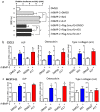Selective small molecule compounds increase BMP-2 responsiveness by inhibiting Smurf1-mediated Smad1/5 degradation
- PMID: 24828823
- PMCID: PMC4021816
- DOI: 10.1038/srep04965
Selective small molecule compounds increase BMP-2 responsiveness by inhibiting Smurf1-mediated Smad1/5 degradation
Abstract
The ubiquitin ligase Smad ubiquitination regulatory factor-1 (Smurf1) negatively regulates bone morphogenetic protein (BMP) pathway by ubiquitinating certain signal components for degradation. Thus, it can be an eligible pharmacological target for increasing BMP signal responsiveness. We established a strategy to discover small molecule compounds that block the WW1 domain of Smurf1 from interacting with Smad1/5 by structure based virtual screening, molecular experimental examination and cytological efficacy evaluation. Our selected hits could reserve the protein level of Smad1/5 from degradation by interrupting Smurf1-Smad1/5 interaction and inhibiting Smurf1 mediated ubiquitination of Smad1/5. Further, these compounds increased BMP-2 signal responsiveness and the expression of certain downstream genes, enhanced the osteoblastic activity of myoblasts and osteoblasts. Our work indicates targeting Smurf1 for inhibition could be an accessible strategy to discover BMP-sensitizers that might be applied in future clinical treatments of bone disorders such as osteopenia.
Figures







References
-
- Chen D., Zhao M. & Mundy G. R. Bone morphogenetic proteins. Growth Factors 22, 233–241 (2004). - PubMed
-
- Ackerman S. J., Mafilios M. S. & Polly D. W. Jr Economic evaluation of bone morphogenetic protein versus autogenous iliac crest bone graft in single-level anterior lumbar fusion: an evidence-based modeling approach. Spine (Phila Pa 1976) 27, S94–99 (2002). - PubMed
-
- Boden S. D., Kang J., Sandhu H. & Heller J. G. Use of recombinant human bone morphogenetic protein-2 to achieve posterolateral lumbar spine fusion in humans: a prospective, randomized clinical pilot trial: 2002 Volvo Award in clinical studies. Spine (Phila Pa 1976) 27, 2662–2673 (2002). - PubMed
Publication types
MeSH terms
Substances
LinkOut - more resources
Full Text Sources
Other Literature Sources

